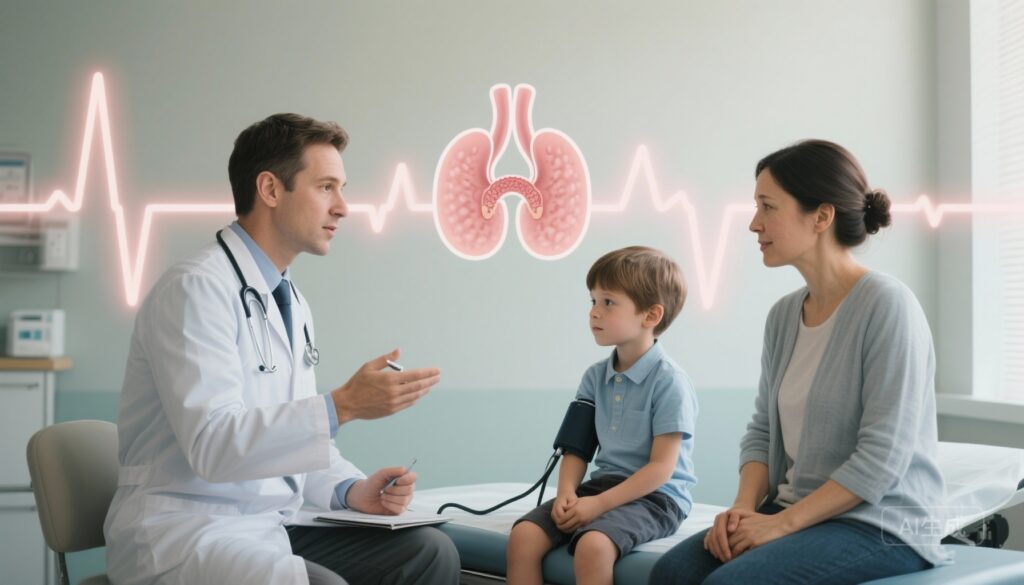Highlights
– In an exploratory secondary analysis of the PATS randomized trial (N=458), early adenotonsillectomy (eAT) produced a mean between‑group 12‑month reduction in systolic BP percentile of −9.02 (95% CI, −14.77 to −3.28) and in diastolic BP percentile of −6.53 (95% CI, −11.02 to −2.03) compared with watchful waiting with supportive care (WWSC).
– The diastolic BP benefit of eAT was larger among children with body mass index (BMI) >85th percentile (interaction estimate −10.40; 95% CI, −19.69 to −1.12; P = .03).
– Findings suggest adenotonsillectomy may confer modest but potentially meaningful short‑term cardiovascular benefit in children with mild obstructive sleep‑disordered breathing (oSDB), particularly in those with overweight/obesity, but confirmatory trials and longer follow‑up are needed.
Background
Snoring and obstructive sleep‑disordered breathing (oSDB) in children exist along a spectrum that ranges from primary snoring to obstructive sleep apnea (OSA). In children, adenotonsillar hypertrophy is the most common anatomical contributor to upper airway obstruction and adenotonsillectomy (AT) is a widely used treatment. While randomized data from the CHAT trial and others demonstrated benefits of AT for behavioral and quality‑of‑life outcomes, the cardiovascular consequences of AT—particularly for blood pressure (BP) —remain incompletely characterized for children with milder disease.
Study design
This article reports an exploratory, prespecified secondary‑outcome analysis of the Pediatric Adenotonsillectomy Trial for Snoring (PATS), a multicenter randomized clinical trial. Children aged 3.0 to 12.9 years with snoring and mild oSDB (obstructive apnea‑hypopnea index [oAHI] <3 events/hour plus tonsillar hypertrophy Brodsky grade ≥2) were randomized to early adenotonsillectomy (eAT) or to watchful waiting with supportive care (WWSC). Participants were recruited across seven tertiary pediatric centers in the United States from June 29, 2016, through February 1, 2021, and followed for 12 months. BP was measured at baseline, 6 months, and 12 months using an automated oscillometric device; results were expressed as age‑, sex‑, and height‑adjusted percentiles. Mixed‑effects models assessed treatment effects on BP trajectories and tested for effect moderation by prespecified covariates, including BMI percentile.
Key findings
Population and baseline characteristics: Of 458 children included in this analysis, mean (SD) age was 6.1 (2.3) years and 50.2% were female. Overweight/obesity (BMI ≥85th percentile) was present in 36.9% of participants. Baseline mean (SD) systolic BP (SBP) percentile was 60.62 (25.22) and diastolic BP (DBP) percentile was 53.86 (21.05). Approximately half (50.4%; n=231) underwent eAT.
Primary BP trajectory results: Over 12 months, SBP and DBP percentiles diverged by treatment arm. In adjusted mixed‑effects models the between‑group differences in change from baseline to 12 months were:
- SBP percentile: −9.02 (95% CI, −14.77 to −3.28) favoring eAT
- DBP percentile: −6.53 (95% CI, −11.02 to −2.03) favoring eAT
Directionally, the eAT group showed decreases in SBP and DBP percentiles over 12 months, while the WWSC group experienced slight increases.
Effect moderation by BMI: Preplanned moderation analyses identified a larger treatment effect on DBP percentile among children with BMI >85th percentile. The interaction effect estimate for DBP was −10.40 (95% CI, −19.69 to −1.12; P = .03), indicating that children with overweight/obesity derived greater diastolic BP benefit from eAT than their normal‑weight peers.
Clinical and statistical interpretation: The magnitude of the between‑group BP percentile differences (≈6–9 percentile points) is modest but potentially meaningful at the population level, especially when concentrated among children who are overweight/obese and at higher baseline cardiovascular risk. Because values are expressed as percentiles, a near 9‑point reduction in SBP percentile could shift a child from a higher percentile category to a more normative range, with uncertain implications for long‑term cardiovascular risk reduction.
Safety and adverse events
The parent trial reported expected perioperative risks associated with AT; this secondary analysis focused on BP outcomes and did not identify additional treatment‑related cardiovascular safety signals. Detailed adverse‑event reporting and surgical complications are documented in the primary PATS publication.
Expert commentary: biological plausibility and clinical context
Mechanistic rationale: Several plausible mechanisms could mediate BP improvement after AT. Even milder upper airway obstruction can increase sympathetic drive, perturb nocturnal BP dipping, and elevate systemic inflammation; adenotonsillectomy may reduce upper airway resistance, improve sleep architecture and oxygenation, and thereby lower sympathetic tone and vascular reactivity. The amplified benefit in children with overweight/obesity may reflect additive effects of obesity‑related sympathetic activation and inflammation, making this subgroup more susceptible to BP increases from disrupted sleep and more responsive to improvements.
Comparison with prior evidence: Earlier randomized studies (notably the CHAT trial) established neurobehavioral and quality‑of‑life benefits for AT in selected children but did not demonstrate consistent cardiovascular effects across cohorts. Observational data have linked pediatric OSA severity with elevations in BP and early markers of vascular dysfunction. The PATS exploratory analysis adds randomized evidence that treating mild oSDB can alter short‑term BP trajectories, at least in a subset of children.
Limitations and generalizability
Key limitations warrant cautious interpretation:
- Exploratory secondary outcome: BP was a secondary, exploratory endpoint of PATS and the trial was not primarily powered to detect BP differences. Findings should be regarded as hypothesis‑generating rather than definitive.
- Measurement method: BP was measured with an automated oscillometric device in clinic settings. Ambulatory blood pressure monitoring (ABPM), which better characterizes nocturnal BP patterns and white‑coat effects, was not used for the primary analysis.
- Population: Participants had mild oSDB (oAHI <3/hr) and tonsillar hypertrophy; results may not apply to children with moderate/severe OSA or without adenotonsillar enlargement. Median follow‑up was 12 months, so longer‑term cardiovascular implications are unknown.
- Residual confounding and adherence: Despite randomization, differential nonstudy treatments, lifestyle changes, or measurement variability could contribute to observed differences. Details on weight trajectories and their role as mediators were not the primary focus here.
Clinical implications
For clinicians caring for children with snoring and mild oSDB, this analysis suggests that eAT may offer modest improvements in BP percentiles over one year compared with watchful waiting. The effect was more pronounced in children with overweight/obesity, raising the possibility that AT could be particularly beneficial for BP control in that subgroup. These findings support consideration of cardiovascular endpoints when counseling families about management options, but decisions should integrate the full balance of symptomatic, behavioral, quality‑of‑life, surgical risk, and weight‑management considerations.
Practically, clinicians may consider baseline and follow‑up BP assessment in children with oSDB—especially those with obesity—and consider shared decision‑making that includes potential cardiometabolic benefits of AT alongside other clinical outcomes.
Research implications and next steps
Important unanswered questions include whether the BP reductions observed are sustained beyond 12 months, whether they translate into measurable reductions in vascular dysfunction or downstream cardiovascular events, and whether ABPM would show larger or different effects, particularly for nocturnal BP patterns and nondipping. Future randomized trials powered for BP and vascular outcomes, with longer follow‑up and inclusion of ABPM and objective measures of autonomic function and inflammation, are needed. Trials should also evaluate how weight management interventions interact with AT to influence cardiovascular outcomes.
Conclusion
This exploratory secondary analysis of the PATS randomized trial found that early adenotonsillectomy produced modest reductions in systolic and diastolic BP percentiles at 12 months compared with watchful waiting in children with mild oSDB; the diastolic benefit was amplified among children with overweight/obesity. The results are hypothesis‑generating and suggest potential short‑term cardiovascular benefit from AT in selected children, while underscoring the need for confirmatory studies with ambulatory BP monitoring and longer follow‑up.
Funding and clinicaltrials.gov
Trial registration: ClinicalTrials.gov Identifier: NCT02562040. Funding sources and detailed acknowledgments are reported in the primary PATS publication.
References
1. Cabrera AJ, Li D, Redline S, et al. Adenotonsillectomy and Blood Pressure in Children With Mild Obstructive Sleep‑Disordered Breathing: An Exploratory Analysis of the PATS Randomized Clinical Trial. JAMA Otolaryngol Head Neck Surg. 2025;151(10):957‑966. doi:10.1001/jamaoto.2025.2555.
2. Marcus CL, Moore RH, Rosen CL, et al. A randomized trial of adenotonsillectomy for childhood sleep apnea. N Engl J Med. 2013;368(25):2366‑2376. doi:10.1056/NEJMoa1215881.
For additional reading on pediatric OSA and cardiovascular risk, consult recent reviews and guideline statements from pediatric sleep medicine and otolaryngology societies.


